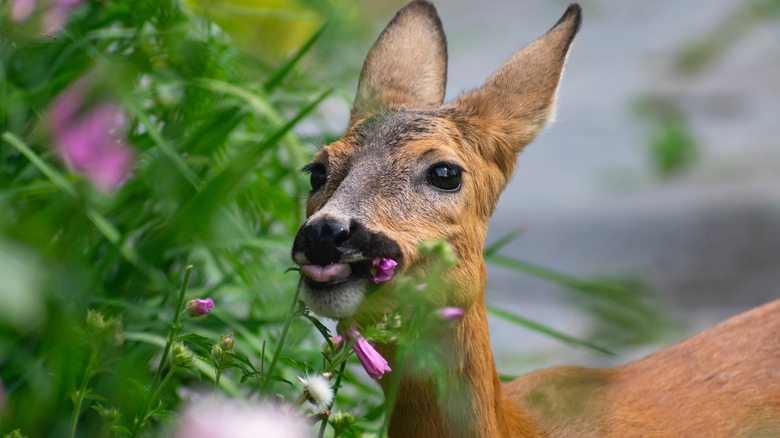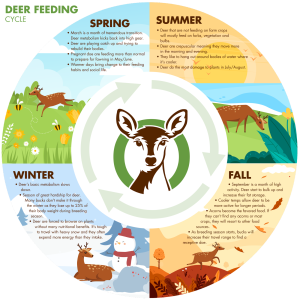

Understanding Whitetail Deer Diet & Feeding Patterns
Did you know the average deer eats 1 ton of food per year? Most deer’s diet is browse, which consists of woody and stemmy plants such as trees, shrubs, briars, and even vine plants. Every day, a deer needs to eat about 6 to 8 percent of its body weight in green foliage and browse to stay healthy.
Urban development destroys whitetail deer’s natural habitat, providing them with less food than they need and forcing them to look for food in your backyard. The Deer population has also increased to about 80 deer per square mile over the past 10 years. The carrying capacity of the land is ideally 5-10 deer per square mile. This is not sustainable meaning the deer are being pushed into our backyards to feed, causing increased damage every year. “For household property damage, it is estimated that deer cause more than $251 million per year in the United States alone.” Deer typically stay within a 5 mile radius so they are limited to the food within that home base. If your yard has a lot of options of food they enjoy, they will make their homes nearby.
Deer Favorites
So what do deer like to eat? A deer’s diet consists of a variety of crops, grasses, vegetation, acorns and nuts. A healthy deer will have a diverse diet with a variety of foods.
In the spring and summer, deer go for new growth. Freshly blooming spring and summer plants like perennials, flowers, hydrangeas, fruit trees, hosta and daylilies are perfect for deer feeding. They prefer them and will gravitate towards them when they pop. In the summer, whitetail deer can eat up to 10 pounds of vegetation per day. In August, the natural food out in the woods has grown a lot taller making it harder to reach and tougher to chew.
During the fall, the average deer can lose up to 30% of its body weight. This means they’re hungry and are willing to eat more plants. In their perfect world, fall would mean feasting from fruit- and nut-bearing trees, but a hungry deer will also devour plant and flower remnants, shrubs, leaves, stems and even bark, especially from young trees. They eat what they can because they are trying to build up their fat stores for the winter ahead, when food sources will become even more scarce.
In the winter, deer experience the hardships of diminished food sources as plants die off. They are often left with options of plants that do not offer them any nutritional benefits. Moving on from their natural food, they search for easier meals such as evergreens like arborvitae and yews. They also eat holly and rhododendrons in the winter.

What does Deer Feeding look like?
Deer only have bottom teeth, so they can’t bite through plants cleanly. The top of their mouth is hard and calice, so they feed by pinching and pulling. When they rip and tear on plants, they leave behind a flat and ragged cut on stems. You’ll usually see threads at the end of the plants where the deer tore the plant. Sometimes, they’ll pull the plant right out of the ground. Deer are messy eaters, ripping at foliage and leaving some behind without finishing. Deer can browse as high as 6 feet.
Evidence of deer feeding includes the presence of a browse line on nearby trees. Think of northern white cedar growing along a lakeshore, where there are no green branches until about six feet up. In Minnesota, the browse line is typically around six feet, but with a deep snow depth and a hungry deer, the browse line could be closer to nine feet. Other signs deer were feeding on your property include deer tracks or deer beds nearby. Look at the soil, and you’ll usually see tracks in areas with feeding. If you find piles of oval-shaped deer scat near your eaten plants, this is another clue it was deer that ate your plants.
Types of Feeding
Just like we have snacks or meals, deer also do different types of feeding. Heavily browsed deer feeding can be identified by a clear and steady browse line. Comfort feeding is when deer feed closer to the woods with a good escape route. For example, you might see a row of arborvitae starting at a house and extending out towards the wood line and the trees closer to the woods will experience more feeding than those closest to the home. Regular browsing occurs when deer are nipping at multiple plants. In conclusion, understanding the feeding patterns of whitetail deer provides valuable insights into their behavior and the challenges they face in our ever-changing world. Their dietary preferences, shifting with the seasons, reflect their resourcefulness in finding sustenance.